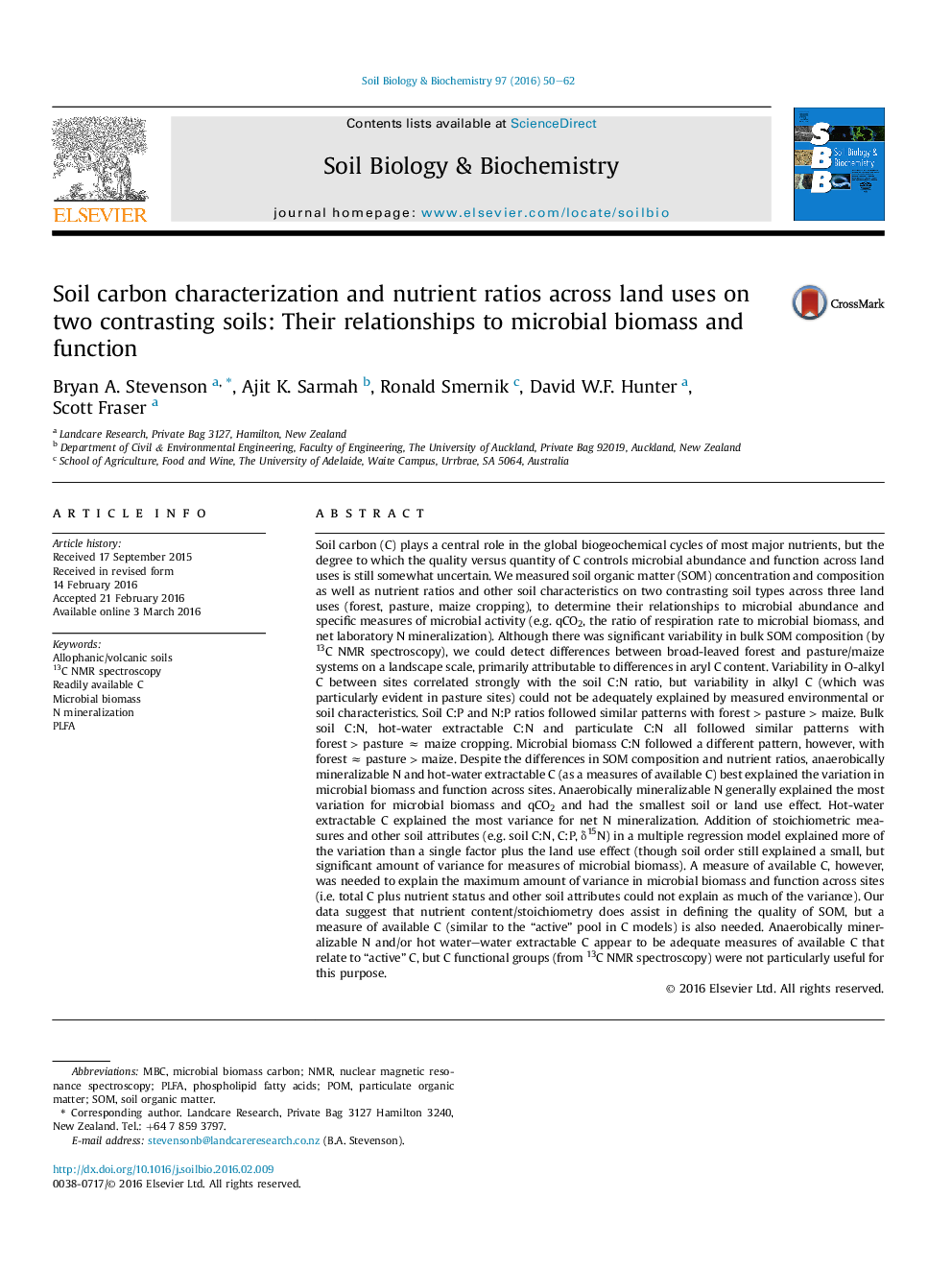| کد مقاله | کد نشریه | سال انتشار | مقاله انگلیسی | نسخه تمام متن |
|---|---|---|---|---|
| 2024319 | 1542587 | 2016 | 13 صفحه PDF | دانلود رایگان |
• Aryl-C of SOM differed between forest and pasture/maize land uses.
• Variation in O-alkyl C across sites was correlated to soil C:N.
• Pastures varied in carbonyl C and alkyl C, with only weak correlations to soil characteristics.
• Measures of available C explained the most variation in microbial biomass and function.
• Available C and specific soil attributes explained the variation associated with land use effects.
Soil carbon (C) plays a central role in the global biogeochemical cycles of most major nutrients, but the degree to which the quality versus quantity of C controls microbial abundance and function across land uses is still somewhat uncertain. We measured soil organic matter (SOM) concentration and composition as well as nutrient ratios and other soil characteristics on two contrasting soil types across three land uses (forest, pasture, maize cropping), to determine their relationships to microbial abundance and specific measures of microbial activity (e.g. qCO2, the ratio of respiration rate to microbial biomass, and net laboratory N mineralization). Although there was significant variability in bulk SOM composition (by 13C NMR spectroscopy), we could detect differences between broad-leaved forest and pasture/maize systems on a landscape scale, primarily attributable to differences in aryl C content. Variability in O-alkyl C between sites correlated strongly with the soil C:N ratio, but variability in alkyl C (which was particularly evident in pasture sites) could not be adequately explained by measured environmental or soil characteristics. Soil C:P and N:P ratios followed similar patterns with forest > pasture > maize. Bulk soil C:N, hot-water extractable C:N and particulate C:N all followed similar patterns with forest > pasture ≈ maize cropping. Microbial biomass C:N followed a different pattern, however, with forest ≈ pasture > maize. Despite the differences in SOM composition and nutrient ratios, anaerobically mineralizable N and hot-water extractable C (as a measures of available C) best explained the variation in microbial biomass and function across sites. Anaerobically mineralizable N generally explained the most variation for microbial biomass and qCO2 and had the smallest soil or land use effect. Hot-water extractable C explained the most variance for net N mineralization. Addition of stoichiometric measures and other soil attributes (e.g. soil C:N, C:P, δ15N) in a multiple regression model explained more of the variation than a single factor plus the land use effect (though soil order still explained a small, but significant amount of variance for measures of microbial biomass). A measure of available C, however, was needed to explain the maximum amount of variance in microbial biomass and function across sites (i.e. total C plus nutrient status and other soil attributes could not explain as much of the variance). Our data suggest that nutrient content/stoichiometry does assist in defining the quality of SOM, but a measure of available C (similar to the “active” pool in C models) is also needed. Anaerobically mineralizable N and/or hot water–water extractable C appear to be adequate measures of available C that relate to “active” C, but C functional groups (from 13C NMR spectroscopy) were not particularly useful for this purpose.
Journal: Soil Biology and Biochemistry - Volume 97, June 2016, Pages 50–62
